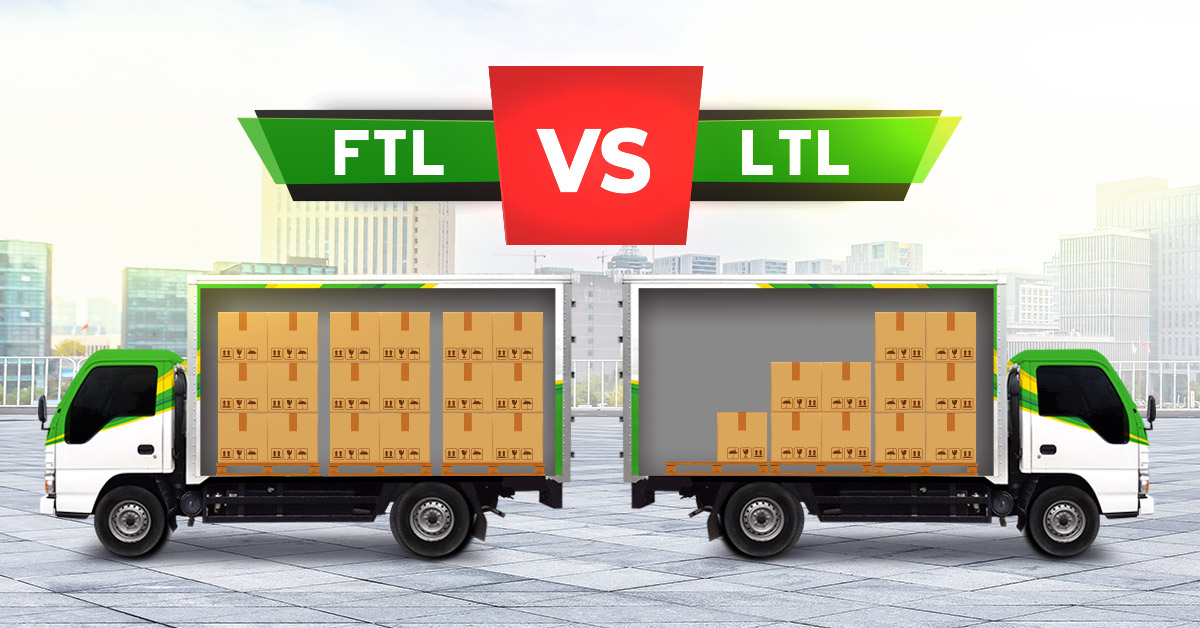
Due to the recent rise in demand for same-day delivery, or “as fast as possible” options, the logistics industry has had to innovate in order to meet these requirements. This has resulted in rapid technological advancement.
The process of shipping and transporting goods from A to B more effectively has experienced a complete overhaul in recent years, with shippers, cargo freight forwarder companies, and other logistics experts developing impressive techniques & strategies to overcome the challenges laid out before them.
That is why businesses must understand the difference between FTL (Full Truckload) and LTL (Less Than Truckload) shipping methods to make better decisions in choosing the right delivery option.
Of course, as more innovation takes place, an already complex industry is fast becoming a minefield for the uninitiated. Thus, it is always worth seeking the expertise of a third party should you wish to stay ahead of the curve.
In this article, we will explore the advantages & disadvantages of FTL service and the advantages & disadvantages of LTL freight shipping in terms of money saved, time spent in delivery, and efficiency of the method.
What is LTL (Less Than Truckload) Shipping?
Less than truckload shipping (LTL) is designed to increase efficiency and cut transportation costs. Without such a method, most companies that ship products would have trouble staying afloat. LTL cargo shipping focuses on filling a single truck with multiple shipments from various clients heading the same route. Carriers, such as Transportify, can offer their clients a reduced price.
Let’s say, for example, that you are an e-commerce company specializing in delivering electronics throughout the Philippines. On average, you might sell 20-30 electronic products; would it then make sense to ship those products in a mostly empty truck on a long-haul trip across the country? It certainly wouldn’t be a cost-effective or maintainable approach to distribution—which is where Less than Truckload shipping (LTL) comes in.
By the time you’ve factored in the cost of fuel consumption, driver wages, and many other financial factors, you will be racking up a significant bill for a relatively small order, and nobody wants that. So, unless you regularly ship vast quantities of products, Less Than Truckload shipping is arguably the most suitable shipping method to explore.
What Are the Advantages of LTL (Less Than Truckload) Shipping?
Maximize profit and minimize cost by filling otherwise unused space in trucks & containers
If you can not fill up the truck with the items you want to transport, then LTL (Less than Truckload) may be a good option for your delivery needs. You can increase savings with LTL because you share the transportation cost with companies that subscribe to the same LTL (Less than Truckload) service. With freight LTL, you don’t have to pay the full amount of renting the truck when your cargo occupies only one-fourth of the total capacity. Thus, this shipping option is ideal for small businesses that can not regularly fill up the capacity of a delivery truck.
Fewer trucks on the road are invariably better for the environment
The environment can greatly benefit from Less than Truckload (LTL) shipping. Instead of one company renting a single truck and only filling up half the total capacity, multiple companies can fill up the truck and transport their goods. Instead of the ratio being one company to one delivery truck, it can now become many companies to a single delivery vehicle. This practice can lessen the number of trucks on the road, which translates to fewer greenhouse gas emissions.
What Are the Disadvantages of LTL (Less Than Truckload) Shipping?
Shipments can be transferred multiple times before arriving at their final destination
Because you share the delivery truck with cargo from other companies, there is a high probability that they move your items when they load and unload cargo from other companies. This setup increases the risk of damaging your items, especially if they are fragile.
The process takes longer than FTL shipping
Depending on the order of deliveries scheduled by your outsourced third-party logistics company, your shipment might be at the bottom of the list. Since many companies have their cargo in the same vehicle, they might be prioritized, meaning their items are delivered first. Being at the bottom of the list regarding delivery orders means that the customer you send the package to will wait a little longer.
What is FTL (Full Truckload) Shipping?
Full Truckload service is quite the polar opposite of LTL shipping in that there is no combined freight from multiple shippers, and thus there are no stops in transit to its destination. There are no additional products inside the truck, only those from one business. This is the costliest form of shipping available, though it is, without question, the most efficient. FTL shipments are palletized and are typically more than 10,000 lbs.
There are two main scenarios where a company can choose FTL shipping. The first is if you have enough cargo to fill up an entire truck. In such a case, the FTL (Full Truckload) transportation service is the perfect choice for your delivery needs. The other case is when you can not fully occupy the truck’s space but want a dedicated truck to deliver your goods. This happens when a company ships fragile and delicate items or if you want your delivery done as fast as possible. However, you would have to factor in the greater cost and offset that with higher delivery charges.
Check the table below to understand better the difference between our Less Than Truckload and Full Truckload services:
What Are the Advantages of FTL (Full Truckload)?
Fast and efficient
In a Full truckload delivery, you rent the entire truck and don’t share space with any other company. Therefore, there are no other stopovers between loading the products from your warehouse to the drop-off point. The FTL option is great for high-risk packages and when there is limited time to deliver your products.
Great for large deliveries
FTL deliveries are designed to transport large quantities of goods to a specific location. A company shipping large volumes of merchandise should take advantage of FTL because it can make the most of the delivery fee. Furthermore, there are many benefits of the FTL, such as a faster delivery time compared to LTL and that the delivery vehicle is not subject to the requirements of other companies.
What Are the Disadvantages of FTL (Full Truckload)?
Unsuitable for companies with regular, smaller orders
The company pays for the entire truck’s space in FTL deliveries, making it worth it if they can occupy it. However, if you are only delivering a small volume of orders, choosing the FTL (Full Truckload) logistics solution may not be an economical option. FTL is ideal for shipments of over 10,000 lbs (4,500 Kg).
Expensive in comparison to the LTL (Less Than Truckload) method
Because you rent the entire truck to deliver your products, then FTL is more expensive than the less than truckload shipping option. Moreover, there is a
Amazon Partner Carrier Programme allows you to ship all pallets to other fulfillment centers in the UK, France, Spain, and Germany at discounts.
With a truckload freight, you still pay the full amount for the truck even though you haven’t taken up much space. Furthermore, you must shoulder the costs alone since you do not share the delivery vehicle with another party.
SEE ALSO:
- {2023} LTL Shipping and Freight Logistics Services
- Freight Transportation Services | LTL Trucking
- Philippine Logistics Industry On LTL Trucking Companies
Which is Better? FTL or LTL?
So, now that you understand both LTL and FTL freight shipping better, how can you decide which is better? Unfortunately, it is difficult to say which is the superior option as many factors can influence their viability for your operation. However, let’s look at a few generalities for your convenience:
- LTL and FTL fluctuate too much in price, so it is difficult to say which is cheapest (either one can work out cheaper depending on your unique situation and requirements)
- FTL is typically faster than LTL
- LTL offers more options and opportunities for small to medium-sized businesses that are trying to expand their operations
- LTL certainly adds more vulnerability to your shipment due to the additional loading and unloading involved
Conclusion
Ultimately, it comes down to the nature of your shipping requirements. If you move a great number of stocks regularly, then FTL (Full Truckload) will almost certainly be the best option for you (especially if the speed of delivery is paramount). However, if you’re a smaller business with less demand, you will have to favor LTL to save money. You have to weigh the pros and cons and factor in the costs involved for each method.
We’d gladly advise if you’re still unsure which method best suits your logistics requirements. Contact Transportify today for a free consultation, and we can see if our services can be of benefit to your business.
How Transportify Can Help Your Business
Transportify, an affordable third-party logistics provider that uses web and mobile apps to facilitate bookings, offers Full Truckload (FTL) and partial load services to its clients so that they can deliver efficiently and swiftly their products to customers. Transportify has several affordable rates to choose from. Therefore, companies can choose the right vehicle for their delivery needs at the right price.
 |
We offer a Business Program (BP) for those companies which need cargo trucking services for their business deliveries. The Business Program will include benefits such as flexible payment options, goods insurance, and an account manager to manage your bookings.
 | or |
What is the difference between FTL and LTL?
🚚 FTL stands for Full Truckload, while LTL stands for Less Than Truckload. The main difference is that FTL involves shipping an entire truckload of cargo, while LTL involves shipping smaller loads that are combined with other shipments. FTL is typically more expensive than LTL because it requires an entire truck. LTL is typically less expensive because the load is combined with other shipments, which helps offset the shipping cost.
What are the benefits of using FTL than LTL?
🚚 There are several benefits to using FTL (full truckload) and LTL (less than truckload) shipping options. First, FTL offers a more efficient way to ship large loads, eliminating the need to break down shipments into smaller units. This can save time and money in the long run. Additionally, FTL provides a higher degree of control over the shipping process, allowing for more precise tracking and delivery times. Finally, FTL can often be more cost-effective than LTL, particularly when shipping large volumes.




 INSTANT QUOTE
INSTANT QUOTE

 Chat
Chat